- Author Matthew Elmers [email protected].
- Public 2023-12-16 21:49.
- Last modified 2025-01-24 09:17.
The combat use of submarines and other underwater vehicles is based on their quality as secrecy of actions for the attacked enemy. The aquatic environment, in the depth of which the PA is operated, limits the detection distance by means of radio and optical location to a value of several tens of meters. On the other hand, the high speed of sound propagation in water, reaching 1.5 km / s, allows the use of noise direction finding and echolocation. Water is also permeable to the magnetic component of electromagnetic radiation, which travels at a speed of 300,000 km / s.

Additional unmasking factors of PA are:
- wake (air-water plume) generated by the propeller (propeller or water jet) in the near-surface layer of water or in deep layers in the event of cavitation on the propeller blades;
- the chemical trace from the exhaust gases of the PA heat engine;
- thermal footprint arising due to the removal of heat from the PA power plant into the aquatic environment;
- radiation footprint left by PA with nuclear power plants;
- surface wave formation associated with the movement of water masses during the movement of the PA.
Optical location
Despite the limited detection distance, optical location has found its application in the waters of tropical seas with high water transparency in conditions of low waves and shallow depths. Optical locators in the form of high-resolution cameras operating in the infrared and visible ranges are installed on board aircraft, helicopters and UAVs, complete with high-power searchlights and laser locators. The swath width reaches 500 meters, the depth of visibility in favorable conditions is 100 meters.

Radar is used to detect raised above the water surface periscopes, antennas, air intakes and the PA themselves on the surface. The detection range using a radar installed on board an aircraft carrier is determined by the carrier's flight altitude and ranges from several tens (retractable PA devices) to several hundred (PA itself) kilometers. In the case of using radio-transparent structural materials and stealth coatings in retractable PA devices, the detection range is reduced by more than an order of magnitude.
Another method of the radar method for detecting submerged aircraft is the fixation of wake waves on the sea surface, generated in the process of hydrodynamic action of the PA hull and propulsion unit on the water column. This process can be observed over a large area of the water area from both aviation and satellite radar carriers, equipped with specialized hardware and software to distinguish the weak relief of the PA wake against the background of interference from wind waves and wave formation from surface ships and the coastline. However, wake waves become distinguishable only when the PA moves at a shallow depth in calm weather.
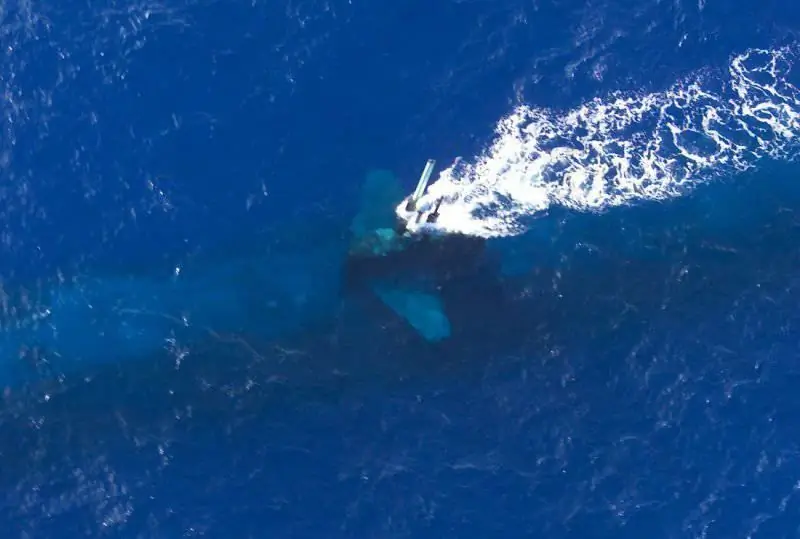
Additional unmasking factors in the form of wake, thermal, chemical and radiation trails are mainly used to pursue the PA in order to covertly control its movement (without reaching the line of hydroacoustic contact) or to produce a torpedo attack from the aft heading angles of the attacked PA. The relatively small track width in combination with the directional maneuvering of the PA forces the pursuer to move along a zigzag trajectory at a speed twice the speed of the PA, which increases the detection distance of the pursuer himself due to the higher level of generated noise and exit from the shadow aft area of the PA. In this regard, the movement along the track is temporary in order to reach the distance of hydroacoustic contact with the PA, which, among other things, makes it possible to qualify the target by the criterion of friend / foe and the type of underwater vehicle.
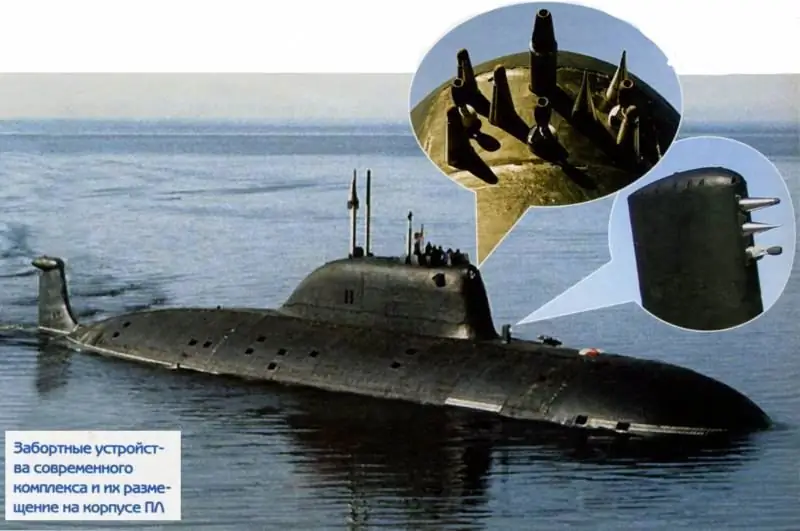
Magnetometric method
An effective method for detecting PA is magnetometric, which operates regardless of the state of the sea surface (waves, ice), the depth and hydrology of the water area, the bottom topography and the intensity of navigation. The use of diamagnetic structural materials in the design of the PA allows only to reduce the detection distance, since the composition of the power plant, the propulsion unit and the PA equipment necessarily includes steel parts and electrical products. In addition, the propeller, the jet impeller and the PA body (regardless of the structural material) in motion accumulate static electric charges on themselves, which generate a secondary magnetic field.
Advanced magnetometers are equipped with superconducting SQUID sensors, cryogenic Dewars for storing liquid nitrogen (similar to the Javelin ATGM), and compact refrigerators for keeping nitrogen in a liquid state.
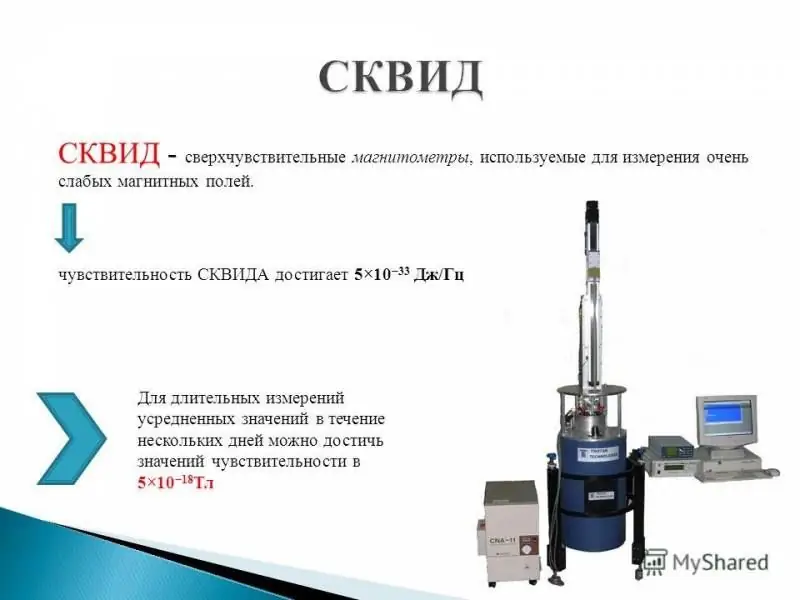
The existing magnetometers have a detection range of a nuclear submarine with a steel hull at the level of 1 km. Advanced magnetometers detect nuclear submarines with a steel hull at a distance of 5 km. Nuclear submarine with a titanium hull - at a range of 2.5 km. In addition to the material of the hull, the magnetic field strength is directly proportional to the displacement of the PA, therefore the small-sized Poseidon-type underwater vehicle with a titanium hull has 700 times less magnetic field than the Yasen submarine with a steel hull, and, accordingly, a smaller detection range.
The main carriers of magnetometers are anti-submarine aircraft of base aviation; to increase the sensitivity, the magnetometer sensors are placed in the fuselage tail protrusion. In order to increase the depth of detection of the PA and expand the search strip, anti-submarine aircraft fly at an altitude of 100 meters or less from the sea surface. Surface carriers use a towed version of magnetometers, underwater carriers use an onboard version with compensation of the carrier's own magnetic field.
In addition to the range limitation, the magnetometric detection method also has a limitation in the magnitude of the speed of movement of the PA - due to the absence of a gradient of its own magnetic field, stationary underwater objects are recognized only as anomalies of the Earth's magnetic field and require subsequent classification using hydroacoustics. In the case of using magnetometers in torpedo / anti-torpedo homing systems, there is no speed limit due to the reverse sequence of target detection and classification during a torpedo / anti-torpedo attack.
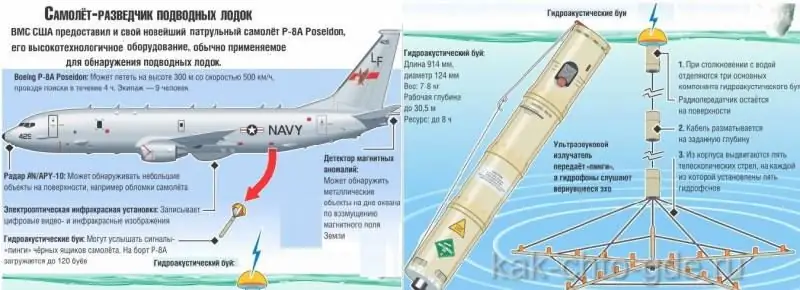
Hydroacoustic method
The most common method for detecting PA is hydroacoustic, which includes passive direction finding of PA intrinsic noise and active echolocation of the aquatic environment using directional radiation of sound waves and reception of reflected signals. Hydroacoustics uses the entire range of sound waves - infrasonic vibrations with a frequency of 1 to 20 Hz, audible vibrations with a frequency of 20 Hz to 20 KHz, and ultrasonic vibrations from 20 KHz to several hundred KHz.
Hydroacoustic transceivers include conformal, spherical, cylindrical, planar and linear antennas assembled from a variety of hydrophones in three-dimensional assemblies, active phased arrays and antenna fields connected to specialized hardware and software devices that provide noise field listening, echolocation pulse generation and reception reflected signals. Antennas and hardware and software devices are combined into hydroacoustic stations (GAS).
Receiving and transmitting modules of hydroacoustic antennas are made of the following materials:
- polycrystalline piezoceramics, mainly lead zirconate-titanate, modified with strontium and barium additives;
- a piezoelectric film of a fluoropolymer modified with thiamine, which transfers the polymer structure to the beta phase;
- fiber-optic laser-pumped interferometer.
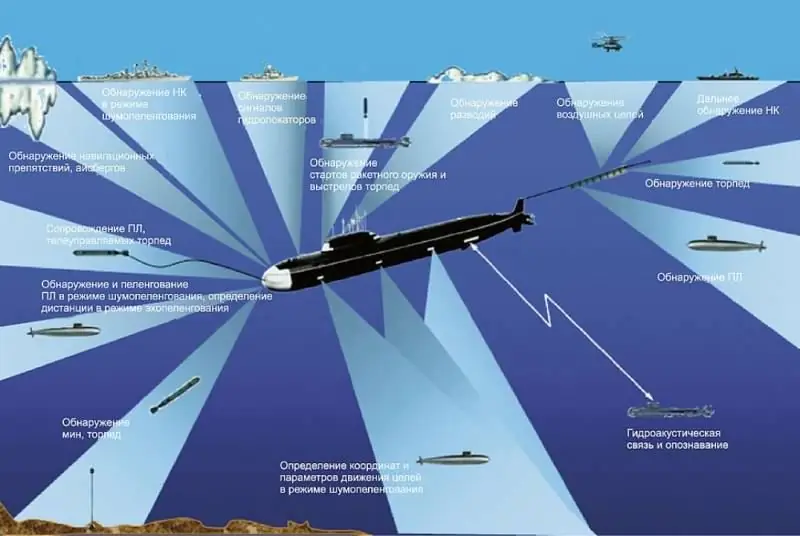
Piezoceramics provides the highest specific power of generation of sound vibrations, therefore it is used in sonars with a spherical / cylindrical antenna of extended range in active radiation mode, installed in the bow of sea carriers (at the greatest distance from the propulsion device generating spurious noises) or mounted in a capsule, lowered to the depth and towed behind the carrier.
Piezofluoropolymer film with a low specific power of generation of sound vibrations is used for the manufacture of conformal antennas located directly on the surface of the hull of surface and underwater vehicles of single curvature (to ensure isotropy of hydroacoustic characteristics), operating to receive all types of signals or to transmit signals of low power.
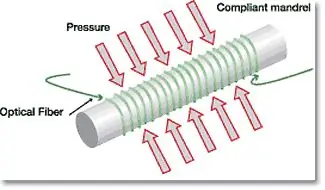
The fiber-optic interferometer works only for receiving signals and consists of two fibers, one of which undergoes compression-expansion under the action of sound waves, and the other serves as a reference medium for measuring the interference of laser radiation in both fibers. Due to the small diameter of the optical fiber, its compression-expansion oscillations do not distort the diffractive front of sound waves (in contrast to piezoelectric hydrophones of large linear dimensions) and allow a more accurate determination of the position of objects in the aquatic environment. Fiber optic modules are used to form flexible towed antennas and bottom linear antennas up to 1 km long.
Piezoceramics is also used in hydrophone sensors, the spatial assemblies of which are part of floating buoys dropped into the sea from anti-submarine aircraft, after which the hydrophones are lowered on a cable to a predetermined depth and go into the noise direction finding mode with the transmission of the collected information over a radio channel to the aircraft. To increase the area of the monitored water area, along with the floating buoys, a series of deep-seated grenades are dropped, the explosions of which hydroacoustically illuminate underwater objects. In the case of using anti-submarine helicopters or quadrocopters to search for underwater objects, an on-board GAS receiver-transmitting antenna, which is a matrix of piezoceramic elements, lowered on a cable-cable, is used.

Conformal antennas made of piezofluoropolymer film are mounted in the form of several sections spaced along the side of the aircraft in order to determine not only the azimuth, but also the distance (using the trigonometry method) to an underwater source of noise or reflected location signals.
Flexible towed and bottom linear optical fiber antennas, despite the relative cheapness, have a negative performance property - due to the long length of the antenna "string", it experiences flexural and torsional vibrations under the action of the incoming water flow, and therefore the accuracy of determining the direction to the object is multiple times worse in comparison with piezoceramic and piezofluoropolymer antennas with a rigid web. In this regard, the most accurate hydroacoustic antennas are made in the form of a set of bobbins wound from fiber optic and mounted on spatial trusses inside acoustically transparent water-filled cylindrical shells that protect the antennas from external influences of water flows. The shells are rigidly attached to foundations located at the bottom and connected by power cables and communication lines with coastal anti-submarine defense centers. If radioisotope thermoelectric generators are also placed inside the shells, the resulting devices (autonomous in terms of power supply) become the category of bottom hydroacoustic stations.
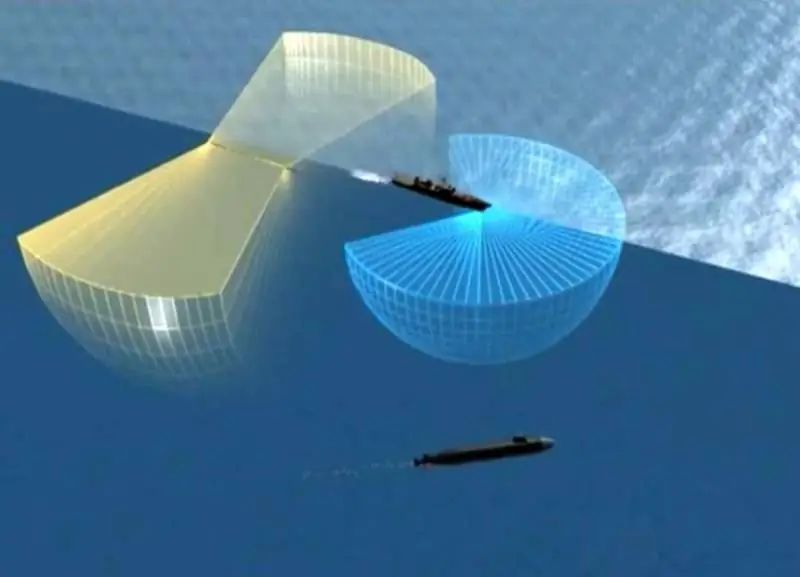
Modern GAS for reviewing the underwater environment, searching for and classifying underwater objects operate in the lower part of the audio range - from 1 Hz to 5 KHz. They are mounted on various marine and aviation carriers, are part of floating buoys and bottom stations, differ in a variety of shapes and piezoelectric materials, place of their installation, power and reception / emission mode. GAS search for mines, countering underwater saboteurs-scuba divers and providing sound underwater communication operate in the ultrasonic range at frequencies above 20 KHz, including in the so-called sound imaging mode with details of objects on a scale of several centimeters. A typical example of such devices is the GAS "Amphora", a spherical polymer antenna of which is installed on the front upper end of the submarine deckhouse fence
If there are several GASs on board or as part of a stationary system, they are combined into a single hydroacoustic complex (GAC) through joint computational processing of active location data and passive noise direction finding. The processing algorithms provide for software detuning from the noise generated by the SAC carrier itself and the external noise background generated by maritime traffic, wind waves, multiple reflection of sound from the water surface and the bottom in shallow water (reverberation noise).
Computational processing algorithms
The algorithms for the computational processing of noise signals received from the PA are based on the principle of isolating cyclically repeating noises from the rotation of the propeller blades, the operation of the electric motor current collector brushes, the resonant noise of the propeller screw gearboxes, vibration from the operation of steam turbines, pumps and other mechanical equipment. In addition, the use of a database of noise spectra typical for a particular type of objects allows you to qualify targets according to the characteristics of friendly / alien, underwater / surface, military / civil, strike / multipurpose submarine, airborne / towed / lowered GAS, etc. In the case of preliminary compilation of spectral sound "portraits" of individual PA, it is possible to identify them by the individual characteristics of the on-board mechanisms.
Revealing cyclically repeating noises and constructing paths for the PA movement requires the accumulation of hydroacoustic information for tens of minutes, which greatly slows down the detection and classification of underwater objects. Much more unambiguous distinctive features of the PA are the sounds of water intake into ballast tanks and their blowing with compressed air, torpedo exit from torpedo tubes and underwater missile launch, as well as the operation of the enemy's sonar in an active mode, detected by receiving a direct signal at a distance that is multiples of the distance reception of the reflected signal.

In addition to the power of the radar radiation, the sensitivity of the receiving antennas and the degree of perfection of the algorithms for processing the received information, the characteristics of the GAS are significantly influenced by the underwater hydrological situation, the depth of the water area, sea surface roughness, ice cover, bottom topography, the presence of noise interference from maritime navigation, sand suspension, floating biomass and other factors.
The hydrological situation is determined by the differentiation of temperature and salinity of the horizontal layers of water, which, as a result, have different densities. At the boundary between the layers of water (the so-called thermocline), sound waves experience full or partial reflection, screening the PA from above or below the search GAS located above. Layers in the water column are formed in the depth range from 100 to 600 meters and change their location depending on the season of the year. The bottom layer of water stagnating in the depressions of the seabed forms the so-called liquid bottom, impervious to sound waves (with the exception of infrasound). On the contrary, in a layer of water of the same density, an acoustic channel arises, through which sound vibrations in the middle frequency range propagate over a distance of several thousand kilometers.
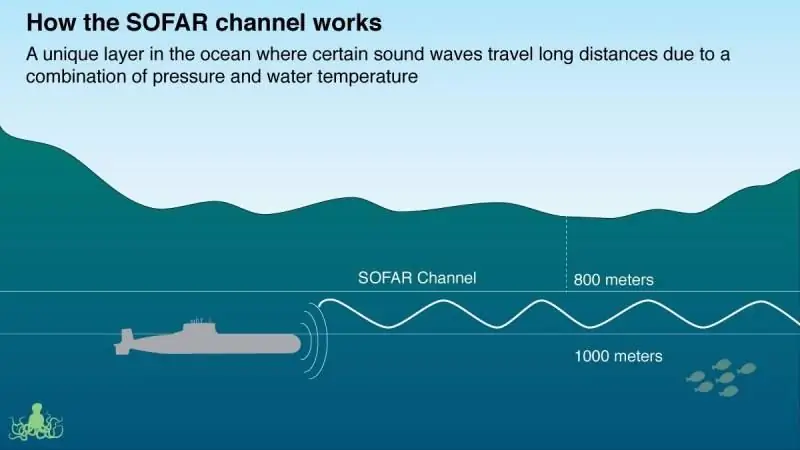
The specified features of the propagation of sound waves under water determined the choice of infrasound and adjacent low frequencies up to 1 KHz as the main operating range of the GAS of surface ships, submarines and bottom stations.
On the other hand, the secrecy of the PA depends on the design solutions of their onboard mechanisms, engines, propellers, the layout and coating of the hull, as well as the speed of the underwater movement.
The most optimal engine
The decrease in the level of intrinsic noise of the PA primarily depends on the power, number and type of propulsion devices. Power is proportional to the displacement and speed of the PA. Modern submarines are equipped with a single water cannon, the acoustic radiation of which is shielded from the bow heading angles by the submarine hull, from the lateral heading angles by the water cannon casing. The field of audibility is limited by narrow aft heading angles. The second most important layout solution aimed at reducing the intrinsic noise of the PA is the use of a cigar-shaped hull with an optimal degree of elongation (8 units for a speed of ~ 30 knots) without superstructures and surface protrusions (except for the deckhouse), with minimal turbulence.
The most optimal engine from the point of view of minimizing the noise of a non-nuclear submarine is a direct current electric motor with a direct drive of the propeller / water cannon, since the AC electric motor generates noise with the frequency of oscillation of the current in the circuit (50 Hz for domestic submarines and 60 Hz for American submarines). The specific gravity of the low-speed electric motor is too high for direct drive at maximum travel speed, therefore, in this mode, the torque must be transmitted through a multi-stage gearbox that generates characteristic cyclic noise. In this regard, the low-noise mode of full electric propulsion is realized when the gearbox is off with a limitation on the power of the electric motor and the speed of the PA (at the level of 5-10 knots).
Submarines have their own peculiarities in the implementation of the full electric propulsion mode - in addition to the noise of the gearbox at low speed, it is also necessary to exclude noise from the circulation pump of the reactor coolant, the pump for pumping the turbine working fluid and the seawater supply pump for cooling the working fluid. The first task is solved by transferring the reactor to natural circulation of the coolant or using a liquid metal coolant with an MHD pump, the second task is by using a working fluid in a supercritical aggregate state and a single-rotor turbine / closed-cycle compressor, and the third by using the pressure of the incoming water flow.
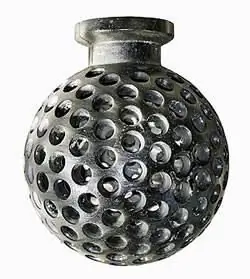
The noise generated by the on-board mechanisms is minimized by the use of active shock absorbers operating in antiphase with the vibrations of the mechanisms. However, the initial success achieved in this direction at the end of the last century had serious limitations for its development for two reasons:
- the presence of large resonator air volumes inside the hulls of submarines to ensure the life of the crew;
- placement of on-board mechanisms in several specialized compartments (residential, command, reactor, engine room), which does not allow the mechanisms to be aggregated on a single frame in contact with the submarine hull in a limited number of points through jointly controlled active shock absorbers to eliminate common mode noise.
This problem can be solved only by switching to small-sized unmanned underwater vehicles without internal air volumes with the aggregation of power and auxiliary equipment on a single frame.
In addition to reducing the intensity of the generation of the noise field, design solutions should reduce the probability of detecting a PA using the echolocation radiation of the GAS.
Counteraction to hydroacoustic means
Historically, the first method of countering active sonar search means was to apply a thick-layer rubber coating to the surface of submarine hulls, first used on the Kriegsmarine "electric bots" at the end of World War II. The elastic coating largely absorbed the energy of the sound waves of the location signal, and therefore the power of the reflected signal was insufficient to detect and classify the submarine. After the adoption of nuclear submarines with a submersion depth of several hundred meters, the fact of compression of the rubber coating by water pressure with the loss of the properties of absorbing the energy of sound waves was revealed. The introduction of various sound-scattering fillers into the rubber coating (similar to the ferromagnetic coating of aircraft that scatters radio emission) partially eliminated this defect. However, the expansion of the operating frequency range of the GAS into the infrasound region has drawn a line under the possibilities of using an absorbing / scattering coating as such.
The second method of counteracting active hydroacoustic search means is a thin-layer active coating of the hull, which generates oscillations in antiphase with the echo-location signal of the GAS in a wide frequency range. At the same time, such a coating solves the second problem without additional costs - the reduction to zero of the residual acoustic field of the PA intrinsic noise. A piezoelectric fluoropolymer film is used as a thin-layer coating material, the use of which has been developed as a basis for HAS antennas. At the moment, the limiting factor is the price of coating the hull of nuclear submarines with a large surface area, therefore, the primary objects of its application are unmanned underwater vehicles.
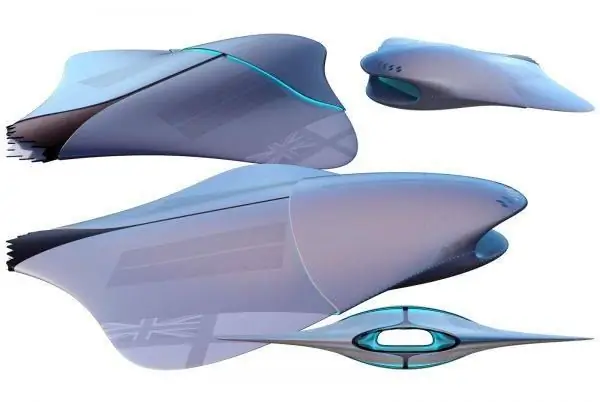
The last of the known methods of counteracting active hydroacoustic search means is to reduce the size of the PA in order to reduce the so-called. target strength - the effective scattering surface of the echo-location signal of the GAS. The possibility of using more compact PAs is based on a revision of the armament nomenclature and a reduction in the number of crews up to the complete uninhabitedness of the vehicles. In the latter case, and as a reference point, the crew size of 13 people of the modern container ship Emma Mærsk with a displacement of 170 thousand tons can serve.
As a result, the target's strength can be reduced by one or two orders of magnitude. A good example is the direction of improvement of the submarine fleet:
- implementation of the projects of NPA "Status-6" ("Poseidon") and XLUUVS (Orca);
- development of projects of nuclear submarines "Laika" and SSN-X with medium-range cruise missiles on board;
- development of preliminary designs for bionic UVA equipped with conformal water-jet propulsion systems with thrust vector control.
Anti-submarine defense tactics
The level of secrecy of underwater vehicles is greatly influenced by the tactics of using anti-submarine defense and counter-tactics of using PA.
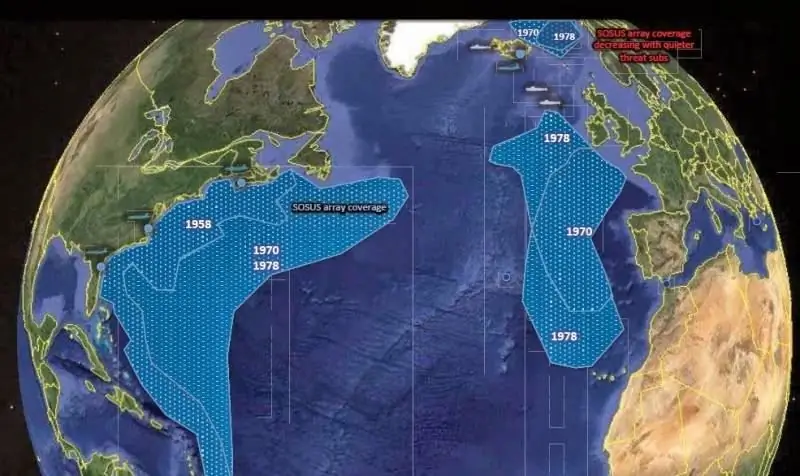
ASW assets primarily include stationary underwater surveillance systems such as the American SOSUS, which includes the following defense lines:
- Cape North Cape of the Scandinavian Peninsula - Bear Island in the Barents Sea;
- Greenland - Iceland - Faroe Islands - British Isles in the North Sea;
- Atlantic and Pacific coast of North America;
- Hawaiian Islands and Guam Island in the Pacific Ocean.
The detection range of fourth-generation nuclear submarines in deep water areas outside the convergence zone is about 500, in shallow water - about 100 km.
While moving under water, the PA is forced from time to time to adjust its actual depth of travel in relation to the specified one due to the pushing nature of the propulsive effect on the body of the underwater vehicle. The resulting vertical vibrations of the housing generate the so-called. surface gravity wave (SGW), the length of which reaches several tens of kilometers at a frequency of several hertz. PGW, in turn, modulates low-frequency hydroacoustic noise (so-called illumination) generated in areas of intense maritime traffic or the passage of a storm front, located thousands of kilometers from the location of the PA. In this case, the maximum detection range of a nuclear submarine moving at a cruising speed, using FOSS, increases to 1000 km.
The accuracy of determining the coordinates of targets using FOSS at the maximum range is an ellipse measuring 90 by 200 km, which requires additional reconnaissance of distant targets by anti-submarine aircraft of base aviation equipped with onboard magnetometers, dropped by hydroacoustic buoys and aircraft torpedoes. The accuracy of determining the coordinates of targets within 100 km from the anti-submarine line of the SOPO is quite sufficient for the use of missile-torpedoes of the corresponding range of coastal and ship-based.
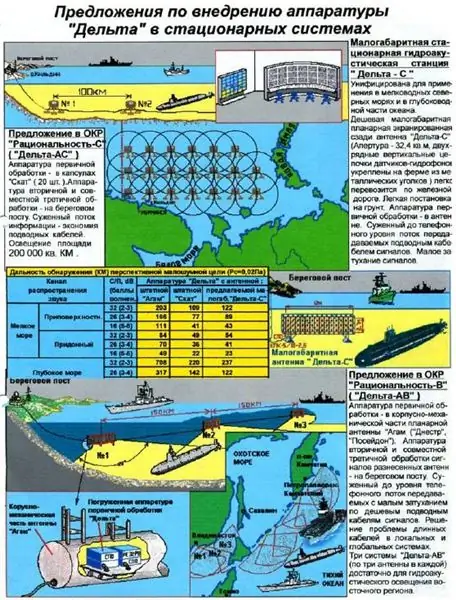
Surface anti-submarine ships equipped with under-keel, lowered and towed GAS antennas have a detection range of fourth-generation nuclear submarines traveling at a speed of 5-10 knots, no more than 25 km. The presence on board the ships of deck helicopters with lowered GAS antennas extends the detection distance to 50 km. However, the possibilities of using shipborne GAS are limited by the speed of the ships, which should not exceed 10 knots due to the occurrence of anisotropic flow around the keel antennas and the breakage of the cable cables of the lowered and towed antennas. The same applies to the case of sea roughness of more than 6 points, which also makes it necessary to abandon the use of deck helicopters with a lowered antenna.
An effective tactical scheme for providing anti-submarine defense of surface ships sailing at an economic speed of 18 knots or in conditions of 6-point sea roughness is the formation of a ship group with the inclusion of a specialized ship to illuminate the underwater situation, equipped with a powerful under-keel GAS and active roll stabilizers. Otherwise, surface ships must retreat under the protection of coastal FOSS and base anti-submarine aircraft, regardless of weather conditions.
A less effective tactical scheme for providing anti-submarine defense of surface ships is the inclusion of a submarine in the ship's group, the operation of the onboard GAS of which does not depend on the sea surface excitement and its own speed (within 20 knots). In this case, the GAS of the submarine must operate in the noise direction finding mode due to the multiple excess of the distance of detecting the echolocation signal over the distance of receiving the reflected signal. According to the foreign press, the detection range of a fourth-generation nuclear submarine under these conditions is about 25 km, the detection range of a non-nuclear submarine is 5 km.
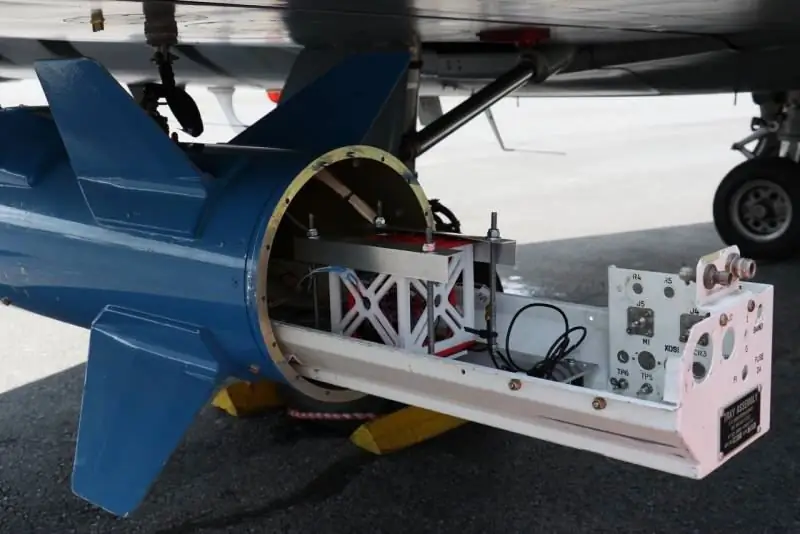
Counter-tactics of using attack submarines include the following methods of increasing their stealth:
- the gap between each other and the target by an amount exceeding the range of action of the GAS SOPO, surface ships and submarines participating in anti-submarine defense, by using the appropriate weapon on the target;
- overcoming the boundaries of the FOSS with the help of a passage under the keel of surface ships and ships for subsequent free operation in the water area, not illuminated by the enemy's hydroacoustic means;
- using the features of hydrology, bottom topography, navigation noise, hydroacoustic shadows of sunken objects and laying the submarine on liquid soil.
The first method assumes the presence of external (generally satellite) target designation or the attack of a stationary target with known coordinates, the second method is acceptable only before the start of a military conflict, the third method is implemented within the operating depth of the submarine and its equipment with an upper water intake system for cooling the power plant or heat removal directly to the PA housing.
Assessment of the level of hydroacoustic secrecy
In conclusion, we can assess the level of hydroacoustic secrecy of the strategic submarine Poseidon in relation to the secrecy of the strike nuclear submarine Yasen:
- the surface area of the NPA is 40 times less;
- the power of the NPA power plant is 5 times less;
- the working depth of submersion of the NPA is 3 times greater.
- fluoroplastic coating of the body against rubber coating;
- aggregation of UUV mechanisms on a single frame against the separation of nuclear submarine mechanisms in separate compartments;
- full electric movement of the submarine at low speed with shutdown of all types of pumps against full electric movement of the nuclear submarine at low speed without shutting down the pumps for pumping condensate and taking water for cooling the working fluid.
As a result, the detection distance of the Poseidon RV, moving at a speed of 10 knots, using modern GAS installed on any type of carrier and operating in the entire range of sound waves in noise direction finding and echolocation modes, will be less than 1 km, which is clearly not enough not only to prevent attacks on a stationary coastal target (taking into account the radius of the shock wave from the explosion of a special warhead), but also to protect the aircraft carrier strike group when it moves in the water area, the depth of which exceeds 1 km.






